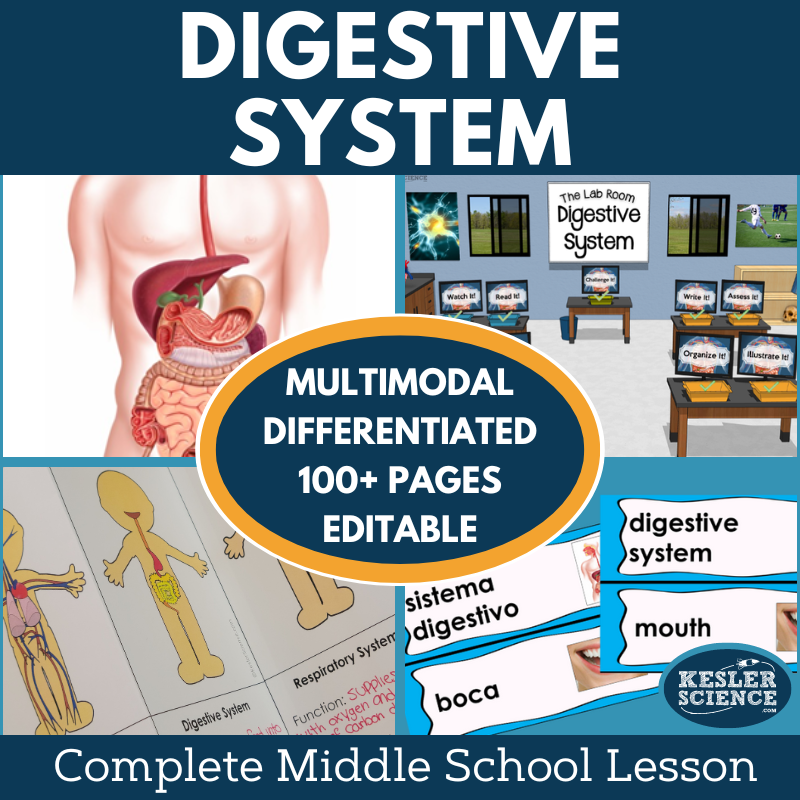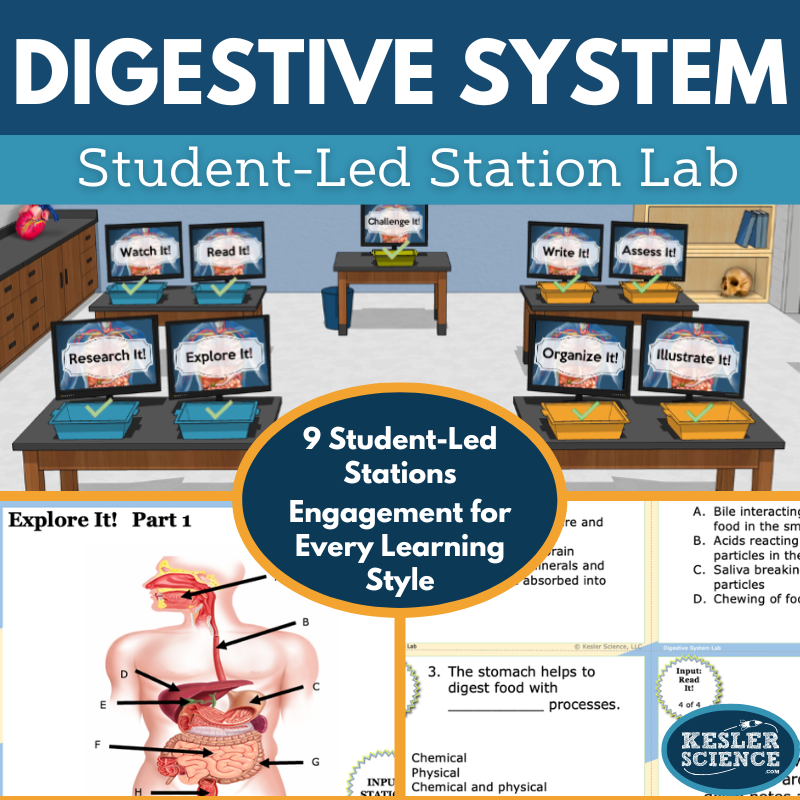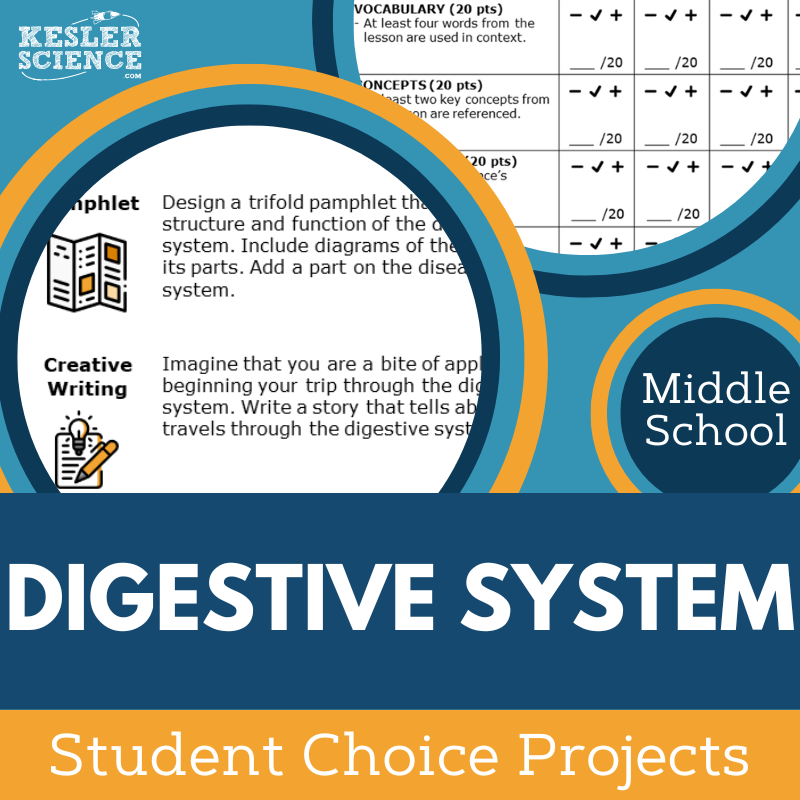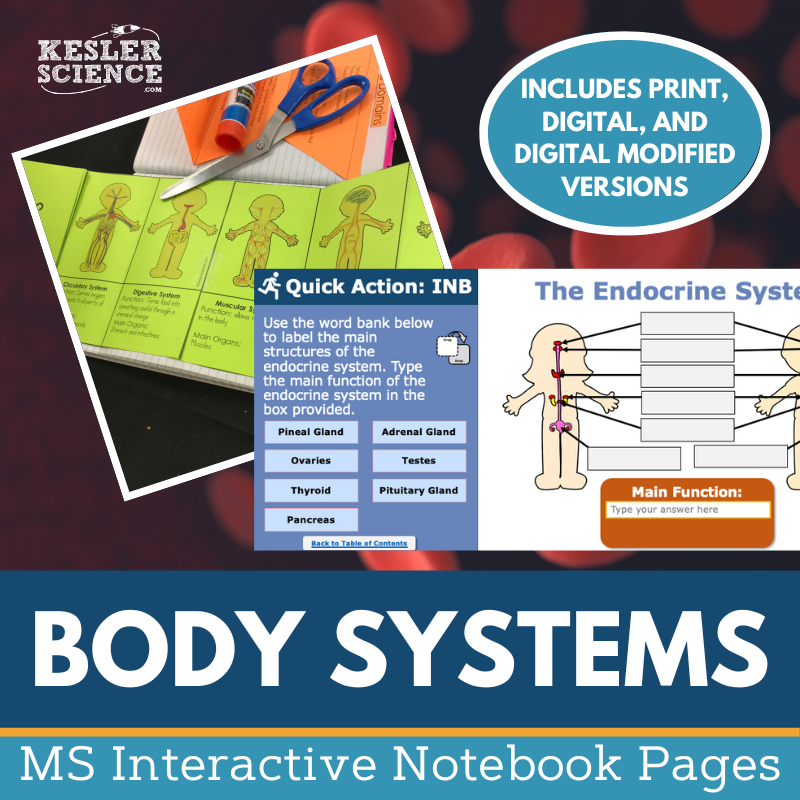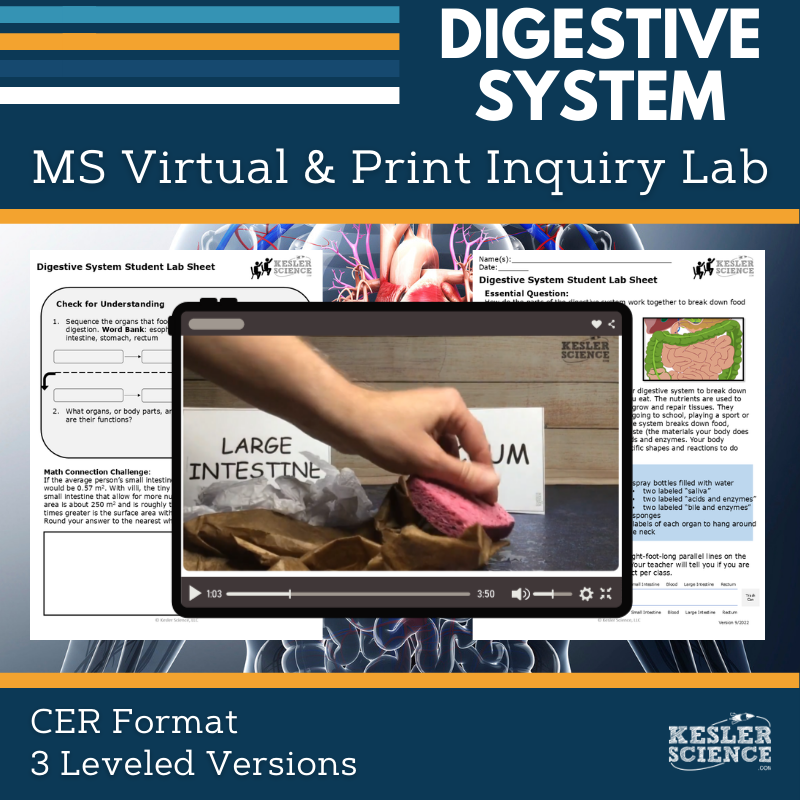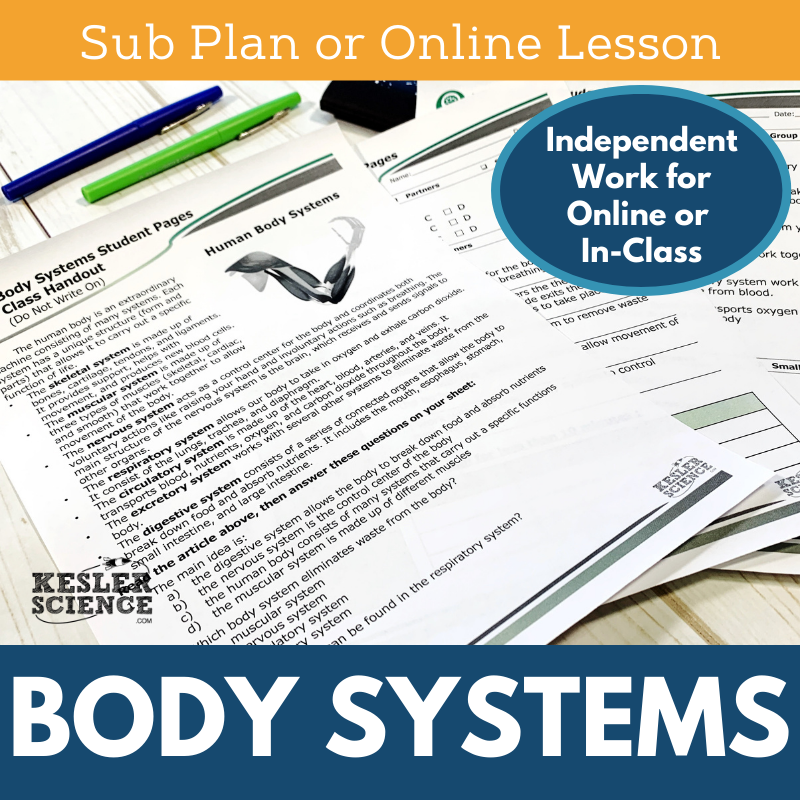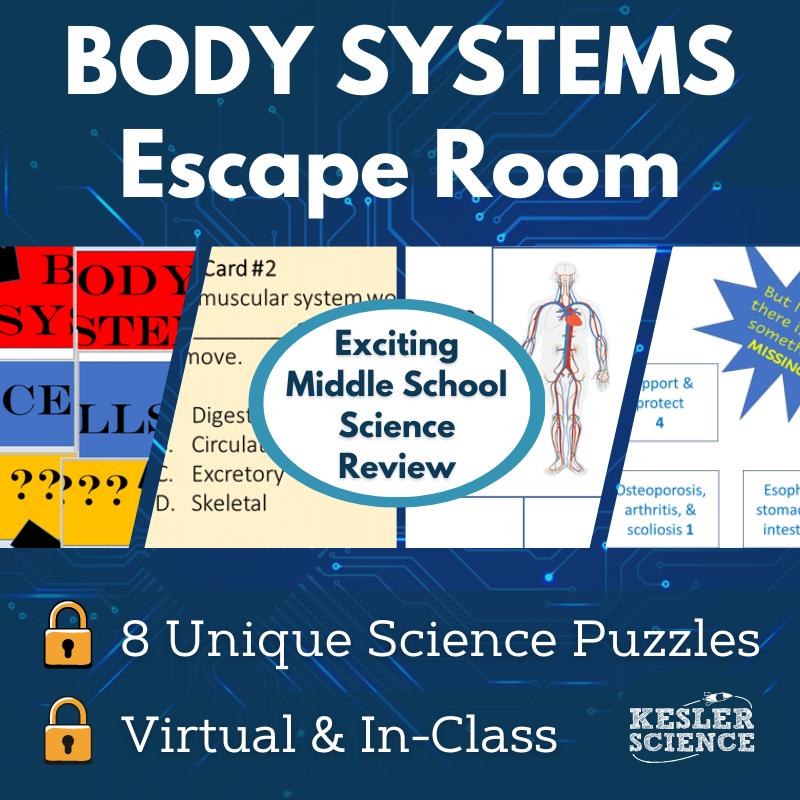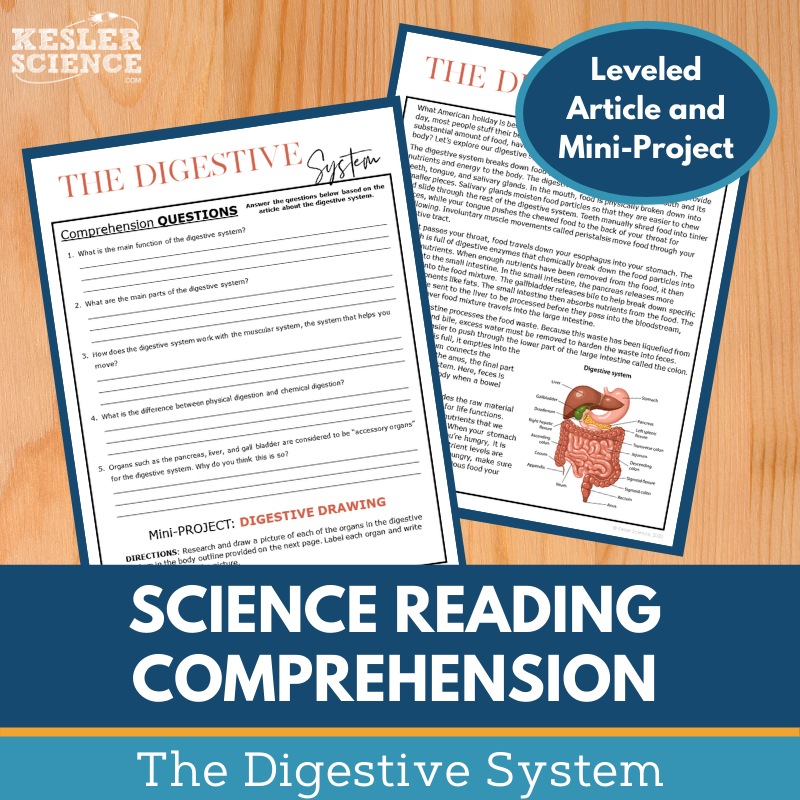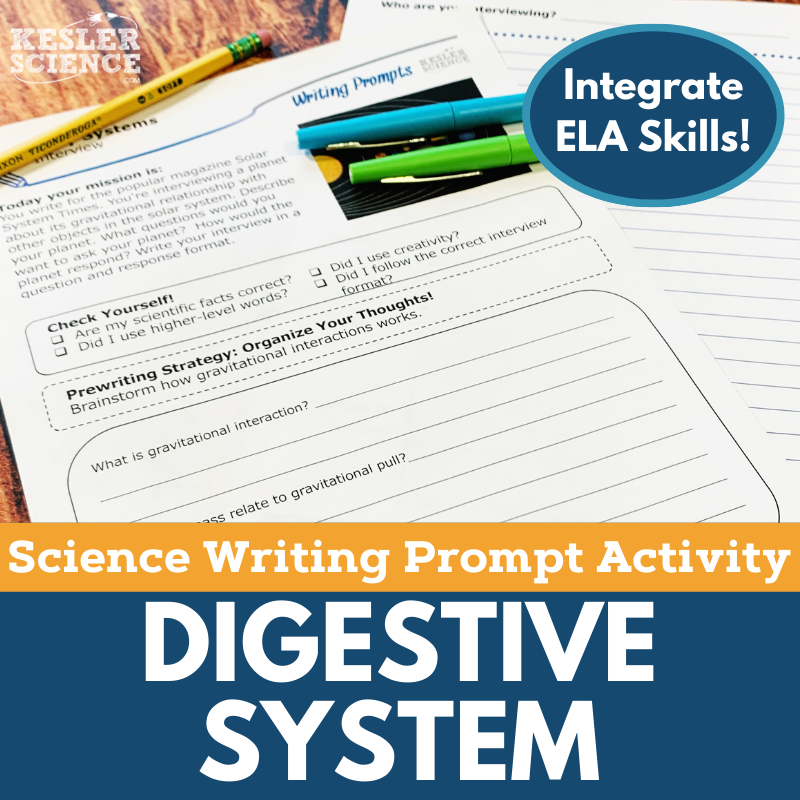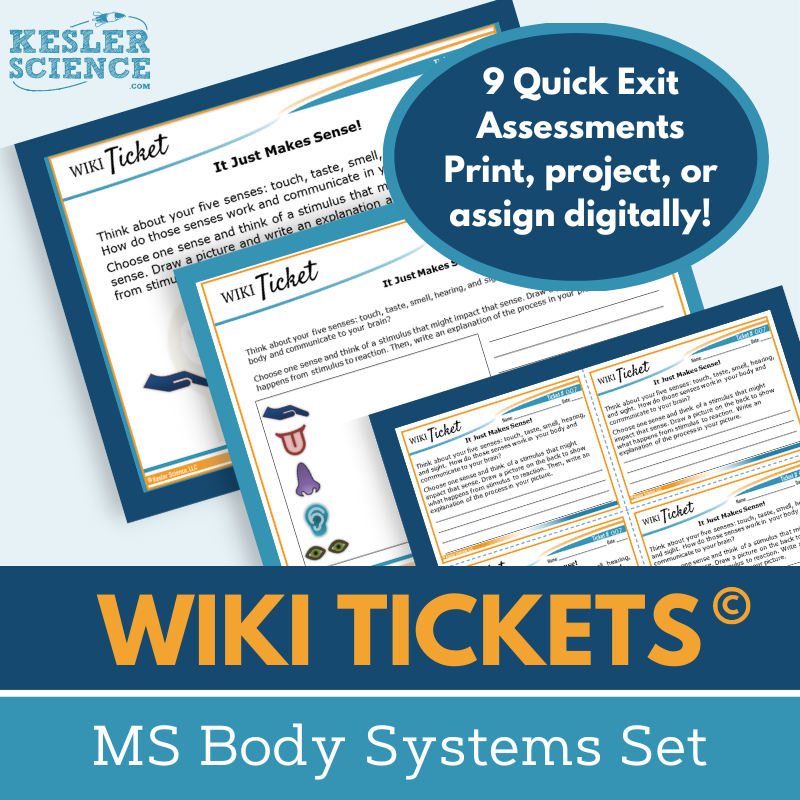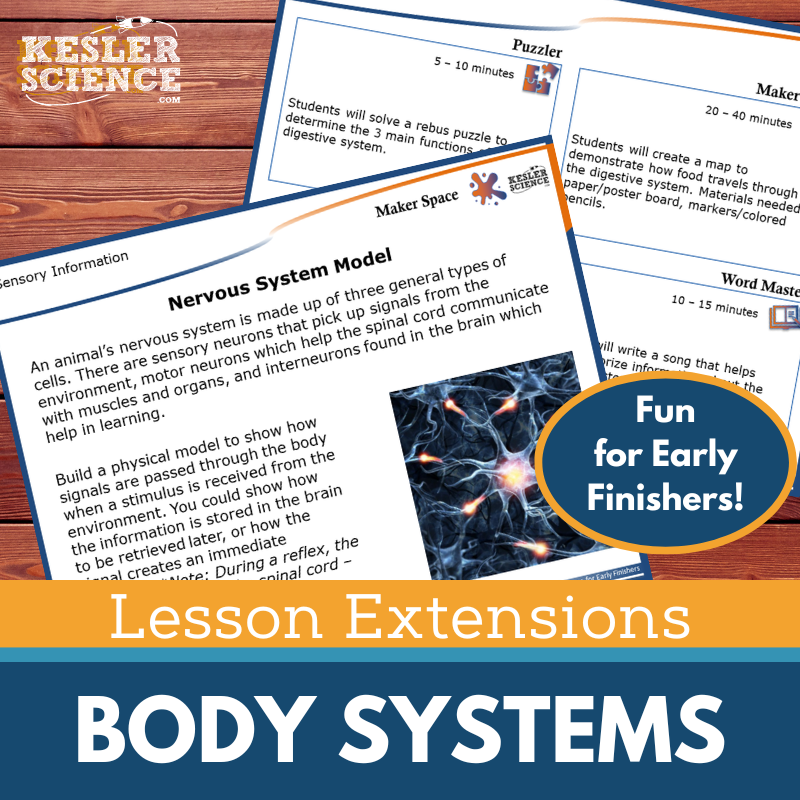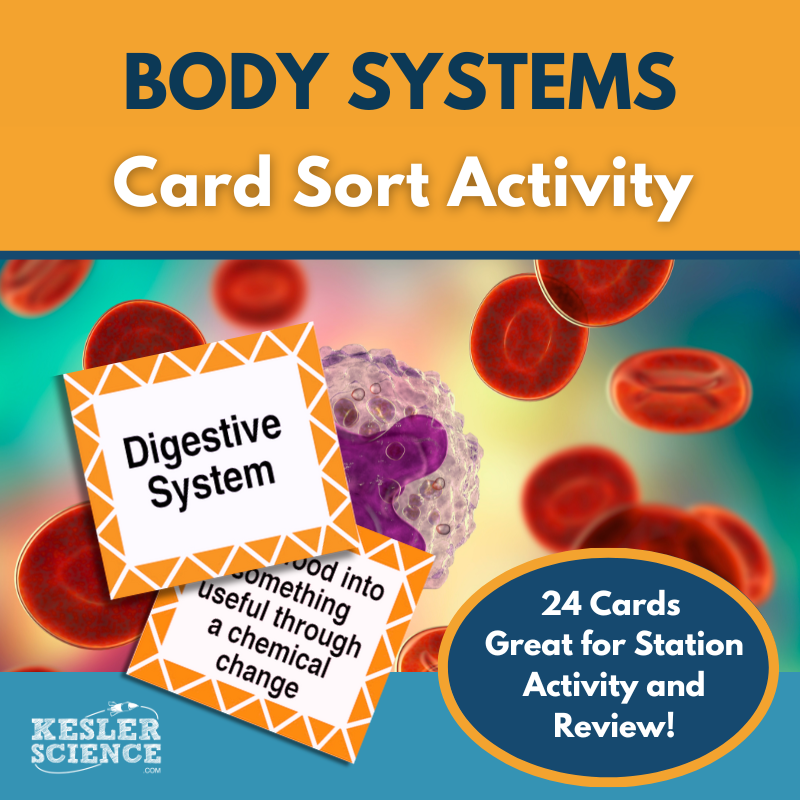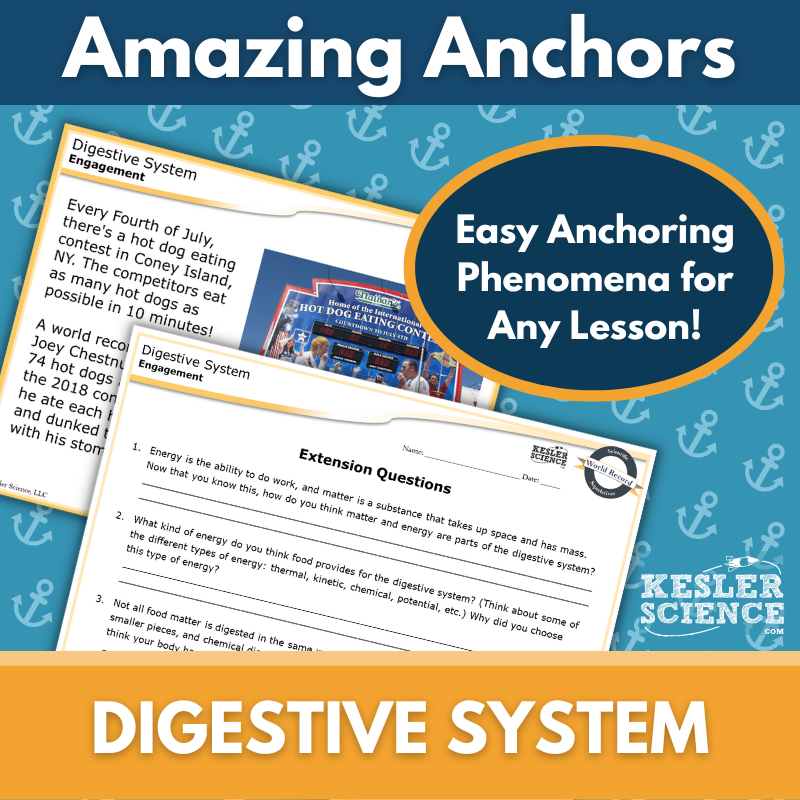Digestive System Activities for Middle School Science
The Kesler Science Digestive System Resources provide a comprehensive, student-centered approach to teaching the digestive system with engaging, differentiated activities for middle school students. The resources below will give students a comprehensive understanding of the digestive system. All of the following materials are also included in the Kesler Science Membership.
The Kesler Science Digestive System Complete 5E Lesson makes lesson planning quick and effective with all the materials you need for an engaging, multi-day lesson. This resource is designed for 6th–8th grade students and offers minimum prep time and student-led learning, allowing you to focus on student success.
The lesson covers essential questions about the digestive system's structure and function, and is based on the 5E Model: Engagement, Exploration, Explanation, Elaboration, and Evaluation. Students interact with differentiated materials, including hands-on activities, research, readings, and videos, with flexible formats for both digital and printable use.
With editable PowerPoints, interactive notebook templates, and Spanish translations, this resource ensures maximum accessibility for all students. It includes a variety of stations to engage students in active learning, and assessment options for evaluating their understanding. The lesson is adaptable for virtual learning, making it suitable for both in-person and remote environments.
The Kesler Science Digestive System Complete 5E Lesson makes lesson planning quick and effective with all the materials you need for an engaging, multi-day lesson. This resource is designed for 6th–8th grade students and offers minimum prep time and student-led learning, allowing you to focus on student success.
The lesson covers essential questions about the digestive system's structure and function, and is based on the 5E Model: Engagement, Exploration, Explanation, Elaboration, and Evaluation. Students interact with differentiated materials, including hands-on activities, research, readings, and videos, with flexible formats for both digital and printable use.
With editable PowerPoints, interactive notebook templates, and Spanish translations, this resource ensures maximum accessibility for all students. It includes a variety of stations to engage students in active learning, and assessment options for evaluating their understanding. The lesson is adaptable for virtual learning, making it suitable for both in-person and remote environments.
The Kesler Science Digestive System Station Lab provides a modular, student-led experience that keeps middle school students engaged in learning about the digestive system. This comprehensive resource saves teachers prep time while allowing students to take charge of their own learning in a hands-on, interactive way.
The lab includes eight differentiated activities, with a ninth challenge station for early finishers, offering a student-centered approach. The nine modular stations feature all the necessary signage, resources, and task cards, allowing students to work independently or in small groups. Some stations may also require basic materials commonly found in classrooms.
Stations include multimodal activities like hands-on experiments, digital resources, reading comprehension, and interactive tasks. Students can organize, illustrate, and write about the digestive system while engaging with tasks such as researching, watching videos, and answering questions. The resource is also adaptable for virtual learning, making it suitable for both in-person and remote environments.
The Kesler Science Digestive System Station Lab provides a modular, student-led experience that keeps middle school students engaged in learning about the digestive system. This comprehensive resource saves teachers prep time while allowing students to take charge of their own learning in a hands-on, interactive way.
The lab includes eight differentiated activities, with a ninth challenge station for early finishers, offering a student-centered approach. The nine modular stations feature all the necessary signage, resources, and task cards, allowing students to work independently or in small groups. Some stations may also require basic materials commonly found in classrooms.
Stations include multimodal activities like hands-on experiments, digital resources, reading comprehension, and interactive tasks. Students can organize, illustrate, and write about the digestive system while engaging with tasks such as researching, watching videos, and answering questions. The resource is also adaptable for virtual learning, making it suitable for both in-person and remote environments.
The Kesler Science Circulatory System Functions Student Choice Projects give middle school students the freedom to select a project that suits their learning style. With six different project options and a "design your own" project, students have creative flexibility, and a grading rubric helps assess vocabulary, concepts, and presentation.
These projects are adaptable, allowing teachers to modify the rubric based on specific grading needs. They offer multimodal choices that support diverse learning styles and encourage personalized, student-led expression.
Included in the purchase are nine project options, teacher directions, and editable rubric pages. The projects are differentiated to accommodate various learning needs, with some options designed for students needing more support and others challenging advanced learners. Most projects require basic classroom supplies, and many can be completed digitally.
The Kesler Science Circulatory System Functions Student Choice Projects give middle school students the freedom to select a project that suits their learning style. With six different project options and a "design your own" project, students have creative flexibility, and a grading rubric helps assess vocabulary, concepts, and presentation.
These projects are adaptable, allowing teachers to modify the rubric based on specific grading needs. They offer multimodal choices that support diverse learning styles and encourage personalized, student-led expression.
Included in the purchase are nine project options, teacher directions, and editable rubric pages. The projects are differentiated to accommodate various learning needs, with some options designed for students needing more support and others challenging advanced learners. Most projects require basic classroom supplies, and many can be completed digitally.
The Kesler Science Body Systems Interactive Notebook Bundle provides a hands-on and engaging way for students to learn about body systems, offering both print and digital options for flexible use in traditional classrooms, 1:1 settings, or distance learning environments. Students can explore key systems, such as the circulatory, digestive, and nervous systems, while interacting with customized templates and reflection pages to enhance understanding.
The digital version features an interactive PowerPoint file that can be uploaded to Google Slides or other platforms like MS Teams or Canvas, making it easy to assign and complete remotely. Students can add notes, complete reflection activities, and access modified templates as needed. The teacher key and modified digital versions ensure accessibility for all learners.
The paper version includes blank and pre-filled templates, along with color photos for guidance, making it ideal for interactive notebooks. This comprehensive bundle offers everything teachers need to support students’ mastery of body system concepts while catering to diverse learning needs.
The Kesler Science Body Systems Interactive Notebook Bundle provides a hands-on and engaging way for students to learn about body systems, offering both print and digital options for flexible use in traditional classrooms, 1:1 settings, or distance learning environments. Students can explore key systems, such as the circulatory, digestive, and nervous systems, while interacting with customized templates and reflection pages to enhance understanding.
The digital version features an interactive PowerPoint file that can be uploaded to Google Slides or other platforms like MS Teams or Canvas, making it easy to assign and complete remotely. Students can add notes, complete reflection activities, and access modified templates as needed. The teacher key and modified digital versions ensure accessibility for all learners.
The paper version includes blank and pre-filled templates, along with color photos for guidance, making it ideal for interactive notebooks. This comprehensive bundle offers everything teachers need to support students’ mastery of body system concepts while catering to diverse learning needs.
The Kesler Science Digestive System Inquiry Lab aligns with NGSS by guiding students through an exploration of the structure and function of the digestive system. Students engage in activities that model mechanical and chemical digestion, investigate the role of enzymes, and understand concepts like peristalsis and nutrient absorption. Both virtual and hands-on print versions include comprehension questions, C.E.R. prompts, and a reflection section to reinforce learning.
Each lab format is differentiated with three levels—Modified, Dependent, and Independent—to support diverse learners. The Modified version offers structured guidance and scaffolded questions, the Dependent level includes guided inquiry with procedures, and the Independent level provides a more student-driven experience. Students might act out the digestive system using materials such as candies, paper bags, and spray bottles, or follow along with a fully virtual experience enhanced by a pre-recorded demonstration video.
The digital files are editable and compatible with Google Slides, and include teacher resources like answer keys, prep information, and standards alignment. Whether students are in class or learning remotely, this lab offers a flexible and engaging way to investigate the essential question, "What is the function of the digestive system?"
The Kesler Science Digestive System Inquiry Lab aligns with NGSS by guiding students through an exploration of the structure and function of the digestive system. Students engage in activities that model mechanical and chemical digestion, investigate the role of enzymes, and understand concepts like peristalsis and nutrient absorption. Both virtual and hands-on print versions include comprehension questions, C.E.R. prompts, and a reflection section to reinforce learning.
Each lab format is differentiated with three levels—Modified, Dependent, and Independent—to support diverse learners. The Modified version offers structured guidance and scaffolded questions, the Dependent level includes guided inquiry with procedures, and the Independent level provides a more student-driven experience. Students might act out the digestive system using materials such as candies, paper bags, and spray bottles, or follow along with a fully virtual experience enhanced by a pre-recorded demonstration video.
The digital files are editable and compatible with Google Slides, and include teacher resources like answer keys, prep information, and standards alignment. Whether students are in class or learning remotely, this lab offers a flexible and engaging way to investigate the essential question, "What is the function of the digestive system?"
The Kesler Science Body Systems Sub Plans guide students through an engaging sequence of activities, including a warm-up puzzle, a reading passage, and a hands-on project to create a booklet labeling the organs and functions of each body system. Using their booklets, students answer questions to deepen their understanding. Extension activities challenge early finishers to explore how systems like the skeletal and muscular systems work together or how multiple systems collaborate to digest a meal. The lesson concludes with an assessment or exit ticket.
Comprehensive support is provided for both in-class and distance learning formats, including substitute teacher instructions, a Google Form answer sheet, and editable resources. Each lesson is thoughtfully crafted to minimize downtime, with substitute directions, behavior checkpoints, and engaging activities to ensure a productive day. Digital versions allow students to annotate PDFs or submit answers online, making the resource versatile for remote or in-person use.
These middle school science sub plans are perfect for days when teachers are out, offering clear instructions for substitutes and meaningful, student-centered activities. They are also ideal for homework, extra credit, or small group sessions. Packed with editable documents, answer keys, and flexible learning formats, these plans make managing classroom learning seamless and stress-free.
The Kesler Science Body Systems Sub Plans guide students through an engaging sequence of activities, including a warm-up puzzle, a reading passage, and a hands-on project to create a booklet labeling the organs and functions of each body system. Using their booklets, students answer questions to deepen their understanding. Extension activities challenge early finishers to explore how systems like the skeletal and muscular systems work together or how multiple systems collaborate to digest a meal. The lesson concludes with an assessment or exit ticket.
Comprehensive support is provided for both in-class and distance learning formats, including substitute teacher instructions, a Google Form answer sheet, and editable resources. Each lesson is thoughtfully crafted to minimize downtime, with substitute directions, behavior checkpoints, and engaging activities to ensure a productive day. Digital versions allow students to annotate PDFs or submit answers online, making the resource versatile for remote or in-person use.
These middle school science sub plans are perfect for days when teachers are out, offering clear instructions for substitutes and meaningful, student-centered activities. They are also ideal for homework, extra credit, or small group sessions. Packed with editable documents, answer keys, and flexible learning formats, these plans make managing classroom learning seamless and stress-free.
The Kesler Science Body Systems Escape Room provides an immersive, hands-on way for students to demonstrate their understanding of major body systems, their structures, and their functions. With eight unique puzzles, teachers have full control over the activities, choosing which puzzles to use and their order—perfect for adapting to different class lengths. This engaging activity combines critical thinking, teamwork, and science content into a memorable classroom experience.
The escape room can be run using simple materials like manila envelopes or with more authentic props, including locks and a storage box, for a realistic feel. Both physical and digital versions are available, offering flexibility for in-person or virtual learning. Digital versions include editable PowerPoints and Google Slides, while printable materials support at-home or classroom setups. Tools like UV pens, red cellophane, and mirrors add to the fun, but alternatives are provided for cost-effective implementation.
The product includes everything needed for a smooth experience: teacher directions, a detailed answer key, a digital answer sheet, editable templates, a mood-setting video challenge, printable props, reward templates, and over 50 prize ideas. Whether used in a physical or digital format, the Kesler Science Escape Room is an engaging and versatile resource for reinforcing body systems knowledge.
The Kesler Science Body Systems Escape Room provides an immersive, hands-on way for students to demonstrate their understanding of major body systems, their structures, and their functions. With eight unique puzzles, teachers have full control over the activities, choosing which puzzles to use and their order—perfect for adapting to different class lengths. This engaging activity combines critical thinking, teamwork, and science content into a memorable classroom experience.
The escape room can be run using simple materials like manila envelopes or with more authentic props, including locks and a storage box, for a realistic feel. Both physical and digital versions are available, offering flexibility for in-person or virtual learning. Digital versions include editable PowerPoints and Google Slides, while printable materials support at-home or classroom setups. Tools like UV pens, red cellophane, and mirrors add to the fun, but alternatives are provided for cost-effective implementation.
The product includes everything needed for a smooth experience: teacher directions, a detailed answer key, a digital answer sheet, editable templates, a mood-setting video challenge, printable props, reward templates, and over 50 prize ideas. Whether used in a physical or digital format, the Kesler Science Escape Room is an engaging and versatile resource for reinforcing body systems knowledge.
The Kesler Science Digestive System Reading Comprehension lesson invites students to explore the digestive system through a nonfiction article, followed by comprehension questions and a hands-on drawing activity. Students deepen their understanding by reading about the digestive system's structures and functions, then applying that knowledge to label and illustrate the system.
The reading passage is tailored for middle school students, with Lexile levels ranging from 1100 to 1300, and includes differentiated comprehension questions and a mini-project. The hands-on activity allows students to reinforce their learning visually, while Cornell notes can be used for additional support. The materials are designed to enhance both science literacy and reading comprehension.
This resource is adaptable for in-person or virtual learning, with files available for platforms like Google Classroom, MS Teams, Schoology, and Canvas. Students can complete the tasks digitally, making this resource perfect for various classroom settings, including remote and hybrid environments.
The Kesler Science Digestive System Reading Comprehension lesson invites students to explore the digestive system through a nonfiction article, followed by comprehension questions and a hands-on drawing activity. Students deepen their understanding by reading about the digestive system's structures and functions, then applying that knowledge to label and illustrate the system.
The reading passage is tailored for middle school students, with Lexile levels ranging from 1100 to 1300, and includes differentiated comprehension questions and a mini-project. The hands-on activity allows students to reinforce their learning visually, while Cornell notes can be used for additional support. The materials are designed to enhance both science literacy and reading comprehension.
This resource is adaptable for in-person or virtual learning, with files available for platforms like Google Classroom, MS Teams, Schoology, and Canvas. Students can complete the tasks digitally, making this resource perfect for various classroom settings, including remote and hybrid environments.
The Kesler Science Digestive System Science Writing Prompt Activity engages middle school students in a creative project where they design a travel brochure to explore the digestive system. This activity helps students extend their science reasoning and enhance their writing skills. It is ideal for both in-class and virtual learning environments, allowing students to stay engaged even outside of the classroom.
Aligned with TEKS and NGSS standards, the writing prompt is a flexible, low-prep, and high-quality resource perfect for elaboration or review. Students can work individually or in groups, using the travel brochure format to demonstrate their understanding of the digestive system’s processes and functions.
Included are teacher directions, a detailed answer guide, and a variety of student handouts. The materials come in both full-sized and half-sheet versions for easy integration into interactive notebooks. The digital version can be used in PowerPoint or Google Slides, allowing for seamless virtual or in-person learning.
The Kesler Science Digestive System Science Writing Prompt Activity engages middle school students in a creative project where they design a travel brochure to explore the digestive system. This activity helps students extend their science reasoning and enhance their writing skills. It is ideal for both in-class and virtual learning environments, allowing students to stay engaged even outside of the classroom.
Aligned with TEKS and NGSS standards, the writing prompt is a flexible, low-prep, and high-quality resource perfect for elaboration or review. Students can work individually or in groups, using the travel brochure format to demonstrate their understanding of the digestive system’s processes and functions.
Included are teacher directions, a detailed answer guide, and a variety of student handouts. The materials come in both full-sized and half-sheet versions for easy integration into interactive notebooks. The digital version can be used in PowerPoint or Google Slides, allowing for seamless virtual or in-person learning.
The Kesler Science WIKI Tickets provide engaging, flexible formative assessments for 6th–8th grade science topics, designed to check student understanding in a fun and interactive way. Aligned with NGSS and TEKS standards, these assessments cover nine body systems, including the circulatory, digestive, endocrine, excretory, muscular, nervous, respiratory, and skeletal systems, as well as sensory information. Each topic includes five formats: projection, full-page, split-page, quarter-page handouts, and editable digital versions for use in PowerPoint or Google Slides.
These colorful WIKI Tickets can be used as exit tickets, bellringers, or quick checks for learning progress. Teachers have the flexibility to use them in print, project them for whole-class responses, or assign them digitally for 1:1 and virtual settings. A bonus table of contents file shows the alignment of each ticket to middle school science standards, ensuring comprehensive coverage of key concepts.
Perfect for both in-person and remote learning, the WIKI Tickets make lesson planning easier while keeping students engaged and on track. These versatile tools ensure you're prepared to assess understanding in any learning environment.
The Kesler Science WIKI Tickets provide engaging, flexible formative assessments for 6th–8th grade science topics, designed to check student understanding in a fun and interactive way. Aligned with NGSS and TEKS standards, these assessments cover nine body systems, including the circulatory, digestive, endocrine, excretory, muscular, nervous, respiratory, and skeletal systems, as well as sensory information. Each topic includes five formats: projection, full-page, split-page, quarter-page handouts, and editable digital versions for use in PowerPoint or Google Slides.
These colorful WIKI Tickets can be used as exit tickets, bellringers, or quick checks for learning progress. Teachers have the flexibility to use them in print, project them for whole-class responses, or assign them digitally for 1:1 and virtual settings. A bonus table of contents file shows the alignment of each ticket to middle school science standards, ensuring comprehensive coverage of key concepts.
Perfect for both in-person and remote learning, the WIKI Tickets make lesson planning easier while keeping students engaged and on track. These versatile tools ensure you're prepared to assess understanding in any learning environment.
The Kesler Science Body Systems Lesson Extensions provide student-choice activities designed to challenge early finishers and deepen their understanding of body systems through engaging, creative, and rigorous learning opportunities. These activities are perfect for ending lessons, filling testing gaps, or keeping students focused with NGSS- and TEKS-aligned content. Students can explore critical thinking and creativity through puzzles, STEAM-based maker activities, digital media projects, and creative writing tasks.
Each extension includes teacher directions, answer keys, projection options for digital boards, and printable handouts in full- and half-sheet formats. Topics covered include the circulatory, digestive, endocrine, excretory, integumentary, muscular, nervous, respiratory, and skeletal systems, as well as sensory information, making them a perfect supplement for anatomy and physiology units.
Kesler Science Lesson Extensions help scaffold learning for independent learners, offering a variety of high-level activities to enhance problem-solving, creativity, and hands-on engagement, all while maintaining alignment with key science standards.
The Kesler Science Body Systems Lesson Extensions provide student-choice activities designed to challenge early finishers and deepen their understanding of body systems through engaging, creative, and rigorous learning opportunities. These activities are perfect for ending lessons, filling testing gaps, or keeping students focused with NGSS- and TEKS-aligned content. Students can explore critical thinking and creativity through puzzles, STEAM-based maker activities, digital media projects, and creative writing tasks.
Each extension includes teacher directions, answer keys, projection options for digital boards, and printable handouts in full- and half-sheet formats. Topics covered include the circulatory, digestive, endocrine, excretory, integumentary, muscular, nervous, respiratory, and skeletal systems, as well as sensory information, making them a perfect supplement for anatomy and physiology units.
Kesler Science Lesson Extensions help scaffold learning for independent learners, offering a variety of high-level activities to enhance problem-solving, creativity, and hands-on engagement, all while maintaining alignment with key science standards.
The Body Systems Card Sort activity helps students learn about the ten major human body systems by sorting them based on their system name, main function, and major organs. This engaging activity can be used during instruction, as a review game, or for intervention and tutoring, providing a fun alternative to traditional study methods.
The body systems included are circulatory, skeletal, endocrine, muscular, integumentary, nervous, digestive, excretory, respiratory, and reproductive. This resource is suitable for any middle school students studying body systems.
The Body Systems Card Sort activity helps students learn about the ten major human body systems by sorting them based on their system name, main function, and major organs. This engaging activity can be used during instruction, as a review game, or for intervention and tutoring, providing a fun alternative to traditional study methods.
The body systems included are circulatory, skeletal, endocrine, muscular, integumentary, nervous, digestive, excretory, respiratory, and reproductive. This resource is suitable for any middle school students studying body systems.
This Amazing Anchors Phenomenon Lesson introduces the digestive system through a real-world scenario—a hot dog eating contest. Students begin with an introductory reading that sets the stage using this engaging phenomenon, followed by comprehension and extension questions to build curiosity and background knowledge. An explanatory reading then unpacks the science behind digestion, connecting the process to the contest in a way that is accessible and easy to understand. Reinforcement questions help deepen student understanding of the system's function.
This resource includes teacher directions, answer keys, projection slides, and both full- and half-sheet handouts. Materials are editable and available in both digital and print formats, making it ideal for use in traditional or virtual classrooms. A differentiated version provides language support and sentence starters for students who need additional help, ensuring that all learners can engage with the content.
Designed to bookend a core lesson, these phenomenon pages are excellent for the Engagement and Elaborate phases of a 5E lesson. They serve as powerful supplements to help students connect scientific concepts to real-life situations, making the digestive system more relevant and memorable.
This Amazing Anchors Phenomenon Lesson introduces the digestive system through a real-world scenario—a hot dog eating contest. Students begin with an introductory reading that sets the stage using this engaging phenomenon, followed by comprehension and extension questions to build curiosity and background knowledge. An explanatory reading then unpacks the science behind digestion, connecting the process to the contest in a way that is accessible and easy to understand. Reinforcement questions help deepen student understanding of the system's function.
This resource includes teacher directions, answer keys, projection slides, and both full- and half-sheet handouts. Materials are editable and available in both digital and print formats, making it ideal for use in traditional or virtual classrooms. A differentiated version provides language support and sentence starters for students who need additional help, ensuring that all learners can engage with the content.
Designed to bookend a core lesson, these phenomenon pages are excellent for the Engagement and Elaborate phases of a 5E lesson. They serve as powerful supplements to help students connect scientific concepts to real-life situations, making the digestive system more relevant and memorable.
Year-Round Resources
These year-round activities will increase your students' understanding of many middle school science topics. All of these activities are also included in the Kesler Science Membership.
Visual Data & Graphing
You're not alone if your students struggle with understanding graphs, charts, and tables. It's a skill that takes an enormous amount of practice. This resource will help students build a strong foundation in analyzing data and creating their own data visualizations.
Bell Ringers and Warm-Ups
These middle school science bell ringers are an excellent way to engage your students as soon as they walk into your classroom. This comprehensive FULL YEAR resource includes everything you need to start off each science class with an interesting warm-up activity.
Review Board Games
Each game board has been carefully designed to keep students engaged. There are 10 different action spaces on each board and dozens of question cards. All of the actions are related to science concepts and keep the students motivated throughout the game.
Each game is ready to play. Simply print out the board and the cards and let the students enjoy reviewing nine different units.
Essential Questions
Below are the essential questions associated with the lessons and activities included in this unit. This topic is only one of more than 100 middle school science topics included in the Kesler Science Membership.
-
What is the main function of the digestive system and how is it structured?
-
What are the main organs associated with this system?
Kesler Science Membership
Imagine never having to search for another middle school science lesson again. The membership gives you access to ALL of the Kesler Science products in one place (Yes, including everything above).
Say goodbye to long hours of lesson prep.

